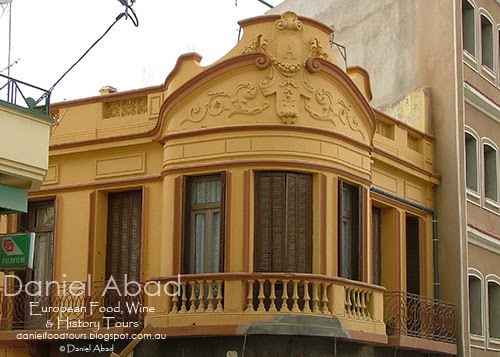Tlemcen is a city in north western Algeria with
an actual population of approximately 200,000 people. It is located sufficiently inland to avoid the humidity of the coast but near
enough to receive cooling sea breezes in summer.
 |
| The City of Tlemcen - View from the Observatory |
Until the independence from France in 1962, Tlemcen was a vacation spot and retreat for French settlers in Algeria, who found it to be far more temperate than Oran or Algiers.
Until the independence from France in 1962, Tlemcen was a vacation spot and retreat for French settlers in Algeria, who found it to be far more temperate than Oran or Algiers.
 |
| Some of the Ornate Architecture in Tlemcen |
 |
| Shady Street in Tlemcen |
Tlemcen was founded by the Romans in the 2nd century as a military outpost. During the Middle Ages, Tlemcen served as a trading city connecting the "coastal" route across the Maghreb with the trans-Saharan caravan routes. It also housed a European trading centre which connected African and European merchants. At the peak of its success, in the first half of the fourteenth century, the city became the principal intellectual centre of the central Maghreb. Tlemcen has more buildings dating from the 12th to the 15th century than any other town in Algeria.
Located in Tlemcen itself, the ruins of the Mansourah are a vestige of an ancient city dating back to the thirteenth century. Today only partial ruins of this magnificent citadel stand and this place has become one of the main tourist attractions of the city. Walking through this historic site gives you a real feeling of its glorious past history.
 |
| The Entrance of the Mansourah Citadel |
 |
| The central tower at the Ruins of the Mansourah Citadel |
 |
| The Walls of the Mansourah Citadel |
During the early years of the French occupation, a broad coalition of natives at Tlemcen continued to resist the latest invaders and the great Berber leader Abd el Kader, fought with incredible valour. His defeat in 1844 temporarily ended the dream of an independent Algeria.
A more recent building, the Abou Bekr Belkaid university has eight faculties and ranks among one of the best in the country. Long considered as the centre for the Arts and Culture, the university attracts a large number of students from all over the country.
 |
| The Entrance of the Tlemcen University |
The Plateau Lalla Setti rises over 700 feet to the south of Tlemcen and overlooks the whole city. The architecture, the view of the city below and the many fountains all make this place a must to visit.
 |
The Tlemcen Observatory tower at the Plateau Lalla Setti |
 |
| Cable Car Arriving at the Observatory |

http://danielfoodtours.blogspot.com.au/
No comments:
Post a Comment